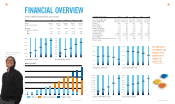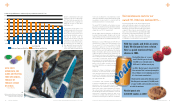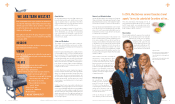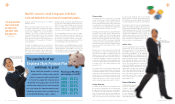Westjet 2003 Annual Report Download - page 9
Download and view the complete annual report
Please find page 9 of the 2003 Westjet annual report below. You can navigate through the pages in the report by either clicking on the pages listed below, or by using the keyword search tool below to find specific information within the annual report.
Yvonne Andal, Supervisor A/R & A/P:
A golf fanatic, she’s determined
to break 100 this year.
I
Overview
WestJet flew through 2003 with strong financial
performance, an expanded network, and a lower cost
structure. Our low-cost, high quality product withstood the
tension and instability our industry faced throughout the
year. We competed not only with old and new rivals, but
also with the negative impact of SARS, mad cow disease,
the war in Iraq, increased airport fees and rates, and
considerably higher fuel prices than the year before.
This year, we witnessed a changing competitive and
operational environment as Canada’s largest air carrier
struggled to emerge from bankruptcy protection, which
has created uncertainty within our industry. During these
challenging times, however, at WestJet we remained
committed to our business plan, resulting in another
profitable year for the Company.
In keeping with our growth strategy, we increased capacity
consistently throughout the year by adding new Next-
Generation Boeing 737-700 aircraft to our fleet. This
aircraft effectively uses the latest in technological
advancements to allow us to realize savings on fuel, extend
our range capabilities, and reduce engine and airframe
maintenance costs.
We added 11 737-700 aircraft and retired two of our
older 737-200s in 2003. We finished the year with a total
of 25 737-700s and 19 737-200 aircraft. During the year,
WestJet converted nine additional purchase options
with Boeing. This brings the total aircraft under firm
commitments to 39, 15 of which we had received by
year-end 2003 with 24 deliveries expected by January
2006, and we have 35 purchase options remaining
through 2008.
We successfully completed several financing arrangements
in 2003, including a bought deal of common shares
issued for a net proceed of $144 million in October, and
a $100 million back-stop equity financing agreement with
Ontario Teachers’ Pension Plan Board in June. In addition,
to support our future growth initiatives, we secured
financing of US $358 million backed by loan guarantees
from the United States government’s Export-Import Bank
(“Ex-Im Bank”) to purchase the 11 aircraft to be delivered
in 2004 and have secured a US $442 million preliminary
commitment from Ex-Im Bank for the remaining 13 aircraft
to be delivered in 2005 and 2006. We have the ability to
draw these funds in Canadian dollars and thereby reduce
our foreign exchange exposure on our aircraft purchases.
As our infrastructure and fleet continues to grow, so to
does our remarkable team of WestJetters. We increased our
workforce by 27.3%, attracting 686 additional full-time-
equivalent employees (“FTEs”) during the year, bringing
our total team of talented people to 3,973 by year-end. To
accommodate our growing operations, we completed an
expansion of our Calgary hangar facility.
We improved our product and level of service to the
seven million guests we welcomed aboard our aircraft in
2003 with an expansion that included the addition of
Windsor, Halifax, Montréal, St. John’s and Gander to our
network. We also increased the overall utilization of our
aircraft by expanding our charter flying, through a
significant agreement with Transat A.T. in the fourth
quarter of 2003. In February 2004, we announced
scheduled transborder service would commence in the
fall of 2004 to the sunny destinations of Los Angeles,
California; Ft. Lauderdale, Florida; Orlando, Florida; Phoenix,
Arizona; and Palm Springs, California.
Highlights of New Initiatives
In line with our philosophy of providing safe,
affordable and fun travel for our guests, we have
taken measures to enhance the efficiency, comfort
and enjoyment of our flights by implementing
several initiatives.
We began a program of installing per-
formance enhancing blended winglet
technology (wingtip extensions) on our
Next-Generation 737-700 aircraft.
Winglets are designed to improve the
aerodynamic performance and handling
characteristics of the aircraft, while extending
aircraft range capabilities and reducing
fuel burn. The benefits we will realize
from this blended winglet technology
on our 737-700 aircraft are estimated
to represent an approximate eight-
year payback.
In October, we revealed our plans to
make our fleet of Boeing Next-
Generation 737-700 series aircraft
more comfortable by offering our
guests more legroom for the longer
time they are spending in the air as
December 21, 2000: $52.3 million (net) share offering completed.
16 | 2003 WestJet Annual Report WestJet formally accepts delivery of first new Next-Generation 737-700 aircraft in May 2001.
++
Rob Lerner, Manager, Revenue Accounting:
He’s looking forward to when
WestJet flies to Thailand.
(He may be waiting a while.)
MANAGEMENT’S DISCUSSION
OF
FINANCIAL RESULTS
AND ANALYSIS
Shirley Saputra, Senior Financial
Reporting Accountant: “Squirley” has a pet fish
named Sushi she keeps with her at the office.
2003 WestJet Annual Report |17
This Management Discussion and Analysis contains forward-looking statements that are
based on management’s current expectations, estimates, projections and assumptions. In
light of the current state of affairs in the domestic and international airline industry, forward-
looking statements must be understood to involve a number of risks and uncertainties.
As a result of many factors, including competition, governmental regulations, fuel pricing,
the airline pricing environment, industry capacity fluctuations, new entrants, foreign
exchange rates, interest rates, labour matters, terrorism, actions by third parties, and
external events, expected results could differ from actual results and differences could
be material. The foregoing list of factors should not be considered exhaustive.
Forward-looking Information
THE STRONGEST
PRINCIPLE OF
GROWTH LIES IN
HUMAN CHOICE.
~ George Eliot






















